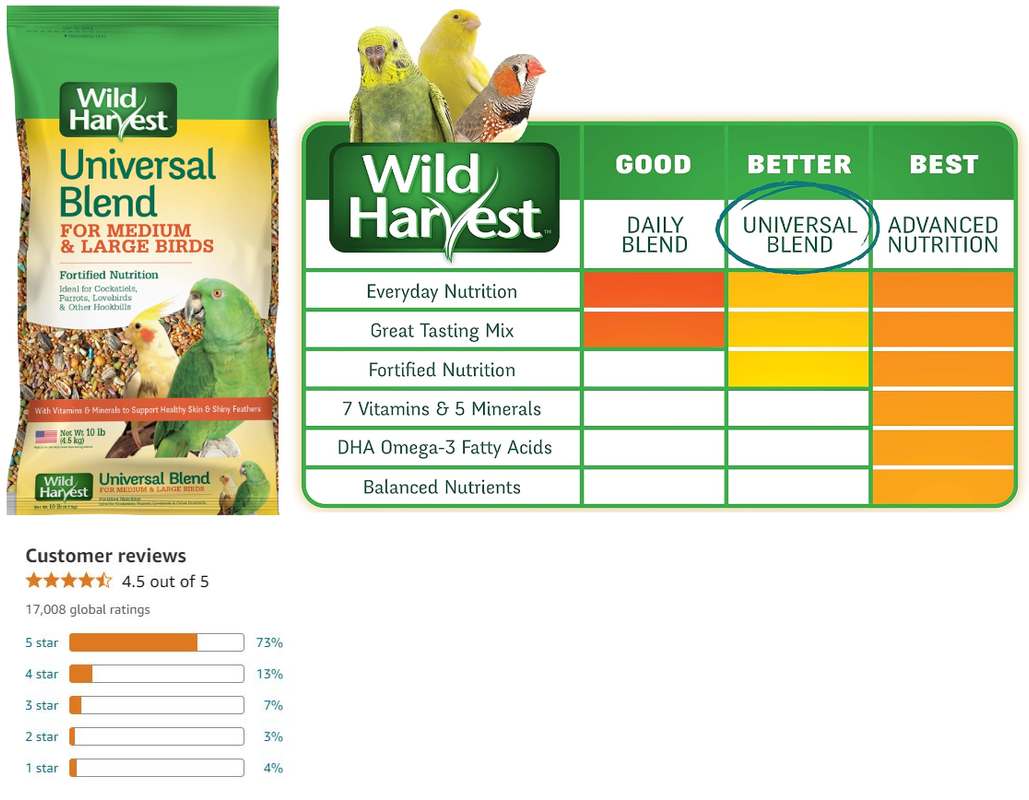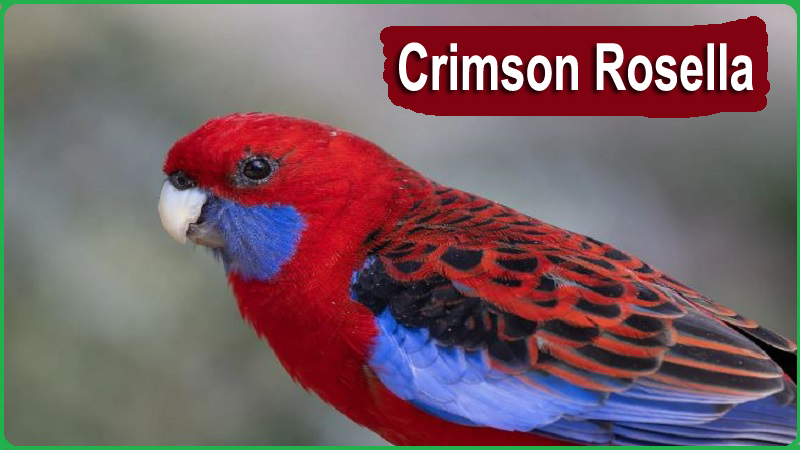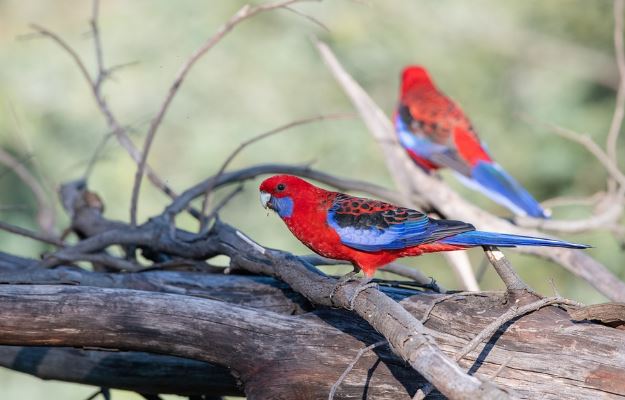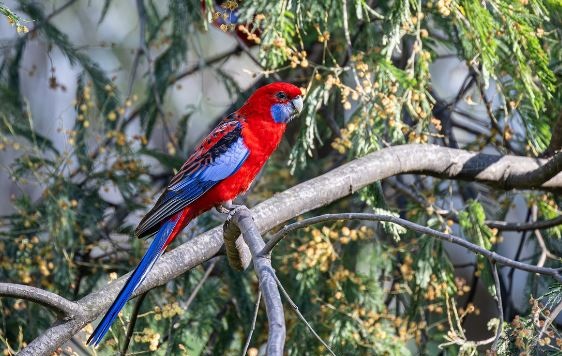The Crimson Rosella parrots native to eastern and south eastern Australia regions. They are well-known due to its striking crimson and blue plumage. Its length measures in 25-36 centimeters.
Rosellas are adaptable birds; who inhabit eucalypt forests, woodlands, and suburban spots. Their diet is depended on seeds, fruits, nuts, nectar, and insects. Social and playful, Crimson Rosellas often like to live small flocks and do communicate via melodious whistles.
Crimson parrots breed duration from September to February. On breeding time, they nest in tree hollows, both parents feeding their chicks. They are threated from habitat loss and predation; still remain a cherished part of Australia’s avian biodiversity.
History Profile of Rosella
First formally, German naturalist Johann Friedrich Gmelind described the crimson rosella in 1788; then he placed it in the parrot genus Psittacus. Later, naturalist Nicholas Aylward Vigors reclassified it into the genus Platycercus, in 1825, which includes the rosella.
Generally, Crimson rosella birds are native to eastern and south eastern Australia region, but after some time, they introduced to other new areas. They were brought to New Zealand around 1910, where they interbred with eastern rosellas.

Later, they were also introduced to Norfolk Island in the 19th century, where they became numerous. Then, IUCN classified it as a species of “Least Concern.”
Species Overview
| Scientific Name | Platycercus elegans |
| Habitat Mountain | Forests and gardens in eastern and south eastern Australia |
| First Described | 1788 by German naturalist Johann Friedrich Gmelin |
| Former Species absorbed | Yellow rosella and Adelaide rosella |
| Genetic Distinctiveness | One of the three red-coloured races, P. e. nigrescens, is genetically more distinct |
Crimson Rosella Identification
The Crimson Rosella birds are easily identified by its vivid crimson-red body and blue cheeks, wings, and tail feathers. Its length measures in 25-36 with a wingspan of 44-55 cm. It’s pale in gray bill and dark brown eyes.
Also Read: Macaws Lifespan in Wild & Captivity
This parrot’s back and wing coverts are black with blue edges that creating a scalloped appearance. Their variations include the Yellow Rosella that has yellow and green plumage, but the Adelaide Rosella, with a mix of red, orange, and yellow.
Despite of getting minimal sexual dimorphism, males are generally slightly larger and more brightly colored as compared to females.
Habitat and Distribution
The Crimson Rosella is generally found in eastern and south eastern Australia, including Tasmania. Mostly, these parrots like to inhabit in different environments, eucalypt forests and rainforests; as well as in woodlands and coastal areas.
They can thrive in both dense forests and open woodlands with their versatility. Besides of this, Crimson Rosellas are frequently looked in suburban gardens, parks, and agricultural areas. Where, they often visit to bird feeders and orchards.
Due to adapt ability in different altitudes, their distribution vary from sea level to mountainous areas. Mostly, these parrots are found in the Murray-Darling basin. Yellow Rosella subspecies are also live in this area.
Cause of their wide distribution and habitat flexibility, they exploit various food sources and nesting sites. Both natural and urban environments are adaptable for Crimson Rosella parrots.
Differences Between Crimson Rosella Male and Female
The main differences between male and female crimson rosellas birds are:
Also Read: Quaker Parrot Colors Mutation: A Spectrum of Colors
Size: Males are generally slightly larger than females.
Plumage Color: Males may display brighter and more intense crimson and blue coloration.
Bill and Eyes: Both sexes have a pale gray bill and dark brown eyes that showing no significant differences.
Courtship Behavior: Males engage in more elaborate courtship displays and are more vocal, especially during the breeding season.
Nesting Duties: Females crimson spend more time incubating eggs and brooding chicks
Appearance: Overall, minimal sexual dimorphism; both sexes look very similar.
Crimson Rosella Colors and Markings
The Crimson Rosella is eminent bird in world, because it’s vivid coloration and distinctive markings. Its body is predominantly bright crimson-red that complemented by striking blue cheeks and shoulder patches. Their wings and back are black with blue edges.
The tail feathers are primarily blue, with some feathers showing white tips. There are some variations exist among subspecies like as the Yellow Rosella features yellow and green plumage. Adelaide Rosella displays the mix of red, orange, and yellow. Its bill is pale gray, and the eyes are dark brown.
Behaviours and Personality
Crimson rosellas exhibit a range of fascinating behaviors and have an engaging personality:
Also Read: How Long Do African Grey Parrots Live? African Grey Lifespan
- Highly social birds, often seen in pairs or small family groups
- Form strong lifelong pair bonds and cooperate in breeding and parental care
- Egalitarian approach to feeding chicks – both parents ensure all young are well-fed
- Intelligent and adaptable, readily visiting backyard feeders and adapting to urban environments
- Playful and curious, engaging in aerial displays and playing with objects
- Excellent whistlers and vocal mimics, able to imitate a variety of sounds
- Devoted to their mate and offspring, with reports of mates caring for injured partners
- Challenging to tame and handle compared to some other parrot species
- Require a large, enriched enclosure and specialized diet to thrive in captivity
Breeding and Lifespan
Breeding for Crimson Rosellas typically occurs from September to February. It is comfortable in Australia’s spring and summer months.
On breeding duration, they start to nest in tree hollows. The female lays 4-8 white eggs that she incubates for about 20 days. Both parents do feeding and caring for the chicks, then get fledge after approximately 5 weeks.
In the wild, Crimson Rosellas can live up to 20 years. But, in captivity they may reach 30 years or more with getting proper care and nutrition. Their longevity totally depends on several factors such as predation, habitat quality, and availability of food resources.
Speech & Sound for Crimson Rosella
Here, we will show you some key aspects of their speech and sounds; as following them:
Vocalizations: Crimson Rosella parrots are known for their diverse range of vocalizations. This includes melodious whistles, chattering, and occasional harsh screeches. They use different calls for communication within their flocks, signaling alarm, and during courtship displays.
Whistles: Their whistles are melodious and clear. They often used to maintain contact with flock members.
Chattering: They engage in chattering sounds during social interactions. This may include mutual preening or playful interactions with other birds.
Alarm Calls: Harsh screeches show warning signals in response to perceived threats. These help to alert other members of the flock to potential danger.
Courtship Displays: During courtship, males may vocalize more frequently and intensely. They also use vocal to attract females for their mating rituals.
Crimson Rosella Populations in Wild
Crimson rosellas mostly live throughout eastern and south eastern Australia, their range scaling from northern Queensland down to southeastern South Australia.
They can easily inhabit in several wooded environments like as tall eucalyptus forests, open woodlands, and even urban parks and gardens.
As an estimate, their overall population is exceeding 200,000, but species suffered some losses due to habitat loss and fragmentation from land clearing.
Crimson rosellas also introduced to other regions, with established populations on Norfolk Island and in New Zealand.
Diet and Nutrition for Crimson Rosella
Crimson Rosellas have a varied diet that reflects their adaptability to different habitats and food sources. Here, we will spread light on their diet and nutrition:
Also Read: Do Cockatiels Have Ears? Their Unique Hearing
Seeds: They primarily feed on seeds from various grasses, shrubs, and trees. Eucalyptus seeds are a significant part of their diet in their native Australian habitats.
Fruits and Nuts: Crimson Rosellas also consume a variety of fruits and nuts, including berries, apples, and almonds. They are known to forage in orchards and gardens for these food items.
Nectar: During the flowering season, they feed on nectar from a wide range of flowering plants. This nectar provides essential carbohydrates and energy, particularly during the breeding season.
Insects: Insects and their larvae are an important source of protein for Crimson Rosellas, supplementing their diet.
Water: Like all birds, Crimson Rosellas require fresh water daily for drinking and bathing. It is essential for maintaining their health and hydration.
Health Problems in Crimson Rosella
Crimson Rosellas are generally hardy birds, but they can be susceptible to various health issues. Common health problems include:
Respiratory Infections: These can occur due to drafts, poor ventilation, or exposure to cold and damp conditions.
Parasites: External parasites like mites and internal parasites such as worms can affect their health if not treated promptly.
Nutritional Deficiencies: Inadequate diet can lead to health issues such as feather problems and weakened immune system.
Beak and Nail Disorders: Overgrown beaks and nails are also serious problem. It can occur if the bird’s environment not suitable materials for natural wear-down.
Accidents and Injuries: Injuries from collisions, falls, or attacks by other animals. It can lead to wounds or fractures that require veterinary attention.
Psychological Stress: Captive birds need good environment and social interaction. If not given them, then may experience stress-related issues, including feather plucking.
Interesting Facts about Crimson Rosella
Crimson Rosellas unique and intriguing characteristics that set them apart in the avian world:
Color Variations: Apart from the iconic crimson and blue plumage, some individuals exhibit rare “yellow morphs,” where parts of their plumage are predominantly yellow instead of crimson.
Urban Adaptability: Crimson Rosellas have successfully adapted to urban environments, thriving in suburban gardens, parks, and visiting bird feeders.
Social Behavior: They are social birds, often forming small flocks outside the breeding season. They are capable to communicate through many vocalizations, like as melodious whistles, chattering, and alarm calls.
Playful Nature: Known for their playful behaviors, they engage in activities like hanging upside down, swinging from branches, and exploring their surroundings.
Mimicry: Crimson Rosellas are capable of mimicking sounds from their environment, including human speech and other bird calls.
FAQs (Frequently Asked Questions)
What is Crimson Rosella?
The Crimson Rosella is a colorful parrot native to eastern and south-eastern Australia. This is well-known for its vibrant red and blue plumage; it inhabits forests, gardens, and parks.
Are Crimson Rosellas Good Pets?
Crimson Rosellas can make good pets for experienced bird owners. They are intelligent, social, and can be quite affectionate.
How Long Do Crimson Rosellas Live?
In captivity, Crimson Rosellas can live up to 20-30 years with proper care. In the wild, their lifespan is typically shorter due to predators and environmental factors.
Do Crimson Rosellas Talk?
Crimson Rosellas are not known for their talking ability like some other parrot species. However, they can mimic sounds and may learn a few words or phrases with training.
Final Remarks
Now, we can hope that you have fully educated about gorgeous Crimson Rosella parrot along with its health & care, diet & nutrition, interesting facts, and unique history profile with ease.
Also Read: Scarlet Macaw Lifespan: Facts & Care Tips for Longevity
If this post is helpful for you, then please share it along with your friends, family members, pet lovers or relatives over social media platforms like as Facebook, Instagram, Linked In, Twitter, and more.
Do you have any experience, tips, tricks, or query regarding on this? You can drop a comment!
Have a Nice Day!!







